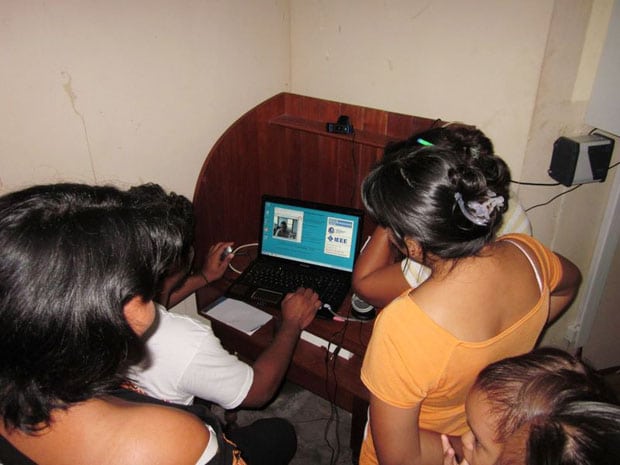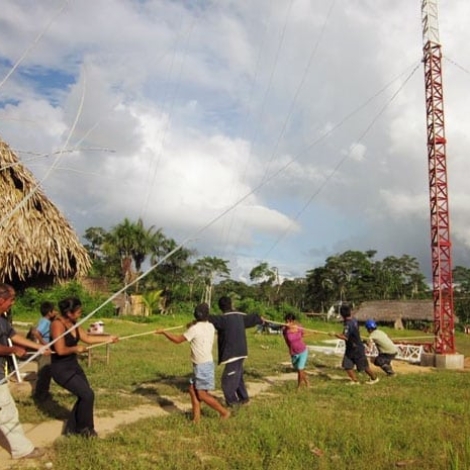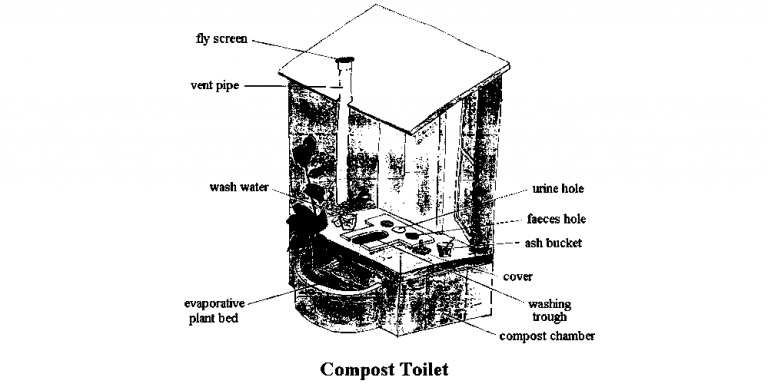Reprinted with permission from IEEE’s The Institute
Three health facilities in Peru’s remote Amazon jungle can now communicate with each other and exchange information with a regional hospital, thanks in part to IEEE volunteers. And the volunteers learned a valuable lesson: A large-scale humanitarian project’s success is determined by the level of involvement of the beneficiaries in implementing, sustaining, and expanding it. Technology is just one piece of the overall picture.
The project came under the umbrella of the Humanitarian Technology Challenge (HTC), a partnership between IEEE and the United Nations Foundation that involved IEEE members, humanitarian aid workers, technologists, and others working on technical solutions for urgent problems that plague developing countries.
[quote author=”IEEE Member Martin Murillo, who headed the project along with IEEE Member Peter Spring.”]“We technologists think that technology is the answer, but that is not quite right. Technology is just a tool that is part of a possible solution to a social problem.”[/quote]
“When I joined HTC, I thought we would be working on developing hardware and software,” Murillo continues. “Instead, what we learned most was how to deal with local politics, culture, and logistics, as well as how to work with partners and part-time unpaid volunteers. Without these issues as the basis, there would not be a solution.”
Perfect environment
Villagers in remote rural areas in the Peruvian Amazon region have little or no access to medical doctors. Regional hospitals with doctors are hundreds of kilometers away, and medical centers with a doctor, nurse, or just a medical technician are few and far between. Mostly, people rely on medical posts housed in small wooden structures staffed by technicians. What’s more, most facilities can be reached only by small boats or long trips on foot. At times neither mode is possible because of low river levels and dangers of the rain forest. Telecoms do not provide digital communications because of the challenging environment to build high towers and the low density of people, according to Murillo.
All the posts lack modern communications and infrastructure systems, like commercial power, mobile telephony, and Internet access.
Those conditions, as well as Peru’s landscape and its relatively safe environment for visitors, made it an ideal candidate for setting up a pilot telemedicine system as part of an overall health improvement solution.
“Once we identified the area in Peru, it took one year to coordinate with the partners, socialize the project to regional and local leaders, acquire the land, and address environmental and religious issues,” Murillo says. The installation and initial configuration of the equipment took one or two days per post. Nurses at the Yurimaguas hospital get their first look at how the telemedicine system works.
IEEE volunteers partnered with various stakeholders including the Peruvian Grupo de Telecomunicaciones Rurales (GTR), which is dedicated to the development of rural telecommunications in Latin America; Pontificia Universidad Católica del Peru; the Alto Amazonas Health Authority, a regional network; the municipality of Balsapuerto; and local indigenous leaders. IEEE HTC provided US $120,000 in funding; the remaining $15,000 came from the health network and the municipality.
The team selected one health post in San Juan, another in Varadero, one health center in Balsapuerto, and a hospital in Yurimaguas. The cities were chosen because of their malnutrition rates and high incidence of disease and maternal mortality.
Including the labor of volunteers, the project would cost more than $350 000, according to Murillo. But “the total amount of funding, time, and effort required for this pilot is not necessarily indicative of what would be required for subsequent installations,” Spring says. “Learning and sharing the knowledge would help reduce that amount.”

Nurses at the Yurimaguas hospital get their first look at how the telemedicine system works. Photo by Martin J. Murillo
Infrastructure
Before the group could even begin to develop the system, it needed to understand the challenges it was likely to face. Accordingly, it met with Peruvian organizations experienced in telehealth networks, rural health center personnel, aid workers, the country’s health authorities, municipal officials, and nongovernmental organizations.
One of the positive things about the area, Murillo says, is that the health network tracks the cases and provides useful indicators and statistics.
The must-do list the group came up with was long: give health care workers the ability to consult with other professionals as well as to lessen their feelings of isolation; reduce unnecessary and expensive trips to regional hospitals; provide health care workers with educational resources; create applications for epidemiological monitoring and inventory control for medical supplies; provide access to health news about local disease outbreaks; and, importantly, assimilate the project as much as possible locally and let the users fit the solution to their cultural context.
Communications was the key component that IEEE and the partners could provide. The system brought in the Internet as well. A network of 2.4-gigahertz and 5.8-GHz Wi-Fi links was installed between the medical outposts and centers and the hospital. Two 60-meter-high communication towers were installed; a total of four towers were outfitted with photovoltaic panels and linked the locations. The system is self-sustaining, working 24/7.
The team spent three months equipping the facilities with solar panels, computers, long-distance Wi-Fi radios, and parabolic antennas, as well as training and working beside the locals. Now technicians at the outposts have access to the outside world. They can share files, access medical records stored in other nodes of the system, and use video-conferencing software to allow doctors at the hospital to diagnose patients remotely. And, in addition to communicating with friends and relatives, the technicians can use the Internet to find information on different diseases, stream educational materials, and arrange for airplanes or boats to transport patients to the hospital.
The system, supported entirely by local personnel, has been working well for almost a year. It has saved lives and reduced trips to the regional hospital. And health care workers are staying at the outposts longer because they can now communicate with their families and friends.
According to Murillo, within a year the team plans to replicate the system in 10 other locations—in Peru, in Bolivia, and in other parts of South America.
Lessons learned
For a project of such a large magnitude, you need a “champion,” a local organization or IEEE section or society with clout and that is excited about the project, says Spring, who was present in Peru at the early stages of the project and also met with authorities.
“Unless you have a champion, the project won’t get done,” Spring says. “Someone needs to steer the project, and coordinate, organize, and implement its design and development. You can’t assume there will be an IEEE group, a technical organization, or a government agency to help. Each project uniquely lends itself to different coalitions of people to make it happen.
“What was evident in our pilot work in Peru is the humanitarian need of telecommunications connectivity to remote health posts was very real and quickly validated by local personnel,” Spring continues. “The identification of this need was due to the direct involvement of humanitarian organizations, like the United Nations Foundation, in the initial work.”
Spring shares more of his lessons in his blog in the IEEE Roundup section. The group seeks to identify development agencies willing to adopt their models and leverage IEEE members around the world for reproducing the solution in other locations.
If you want to get involved in a humanitarian project, check out Engineering for Change (E4C), which seeks to develop technical, locally appropriate, and sustainable solutions to humanitarian challenges. E4C replaces the IEEE Humanitarian Technology Challenge, which ended in December.

